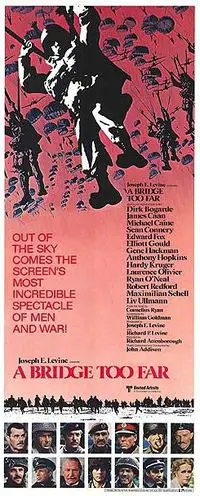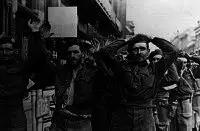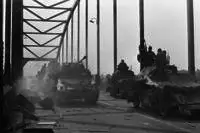Difference between revisions of "How historically accurate is the movie 'A Bridge Too Far'"
| Line 1: | Line 1: | ||
==Introduction== | ==Introduction== | ||
| − | The war movie ‘A Bridge Too Far’’ was one of the hits of 1977. It was a much-anticipated extravaganza that was well received by the public if not all the critics. The movie tells the story of Operation Market Garden. This was an attempt by the allies to seize several key bridges over the Rhine in the Netherlands in 1944. This it was hoped would have allowed the Allies to seize control of key crossing points and then attack Northern Germany from the Netherlands. The plan was to use airborne forces to seize the bridges before the Germans could react. Armored divisions would then join the lightly armed paratroopers and secure them for the allies. However, things did not go to plan and the Germans were at first able to delay the attacks and then defeated the British paratroopers at Arnhem, the offensive’s key objective. Operation Market Garden was widely seen as a failure and resulted in the loss of thousands of Allied paratroopers and soldiers. The 1977 motion picture was directed by Richard Attenborough, a former British movie star. The movie had a huge budget and is visually spectacular. The movie A Bridge Too Far was based on the non-fiction book of the same name written by the journalist Cornelius Ryan<ref> McKenna, A. T. "Joseph E. Levine and A Bridge Too Far: A Producer's Labour of Love". Historical Journal of Film, Radio and Television. 31 (2011), pp 211–214</ref>. Attenborough was committed to making the movie as accurate as possible. The production had several veterans of Market Garden on hand, to give technical advice. One of the stars of the movie was Dirk Bogarde who had fought in the campaign. The movie was a real epic and had an all-star cast. Among its stars were Sean Connery, Ryan O Neill, James Caan, Elliott Gould and Gene Hackman. This article will discuss how accurate is the movie and does it really portray Operation Market Garden | + | The war movie ‘A Bridge Too Far’’ was one of the hits of 1977. It was a much-anticipated extravaganza that was well received by the public if not all the critics. The movie tells the story of Operation Market Garden. This was an attempt by the allies to seize several key bridges over the Rhine in the Netherlands in 1944. This it was hoped would have allowed the Allies to seize control of key crossing points and then attack Northern Germany from the Netherlands. The plan was to use airborne forces to seize the bridges before the Germans could react. Armored divisions would then join the lightly armed paratroopers and secure them for the allies. However, things did not go to plan and the Germans were at first able to delay the attacks and then defeated the British paratroopers at Arnhem, the offensive’s key objective. Operation Market Garden was widely seen as a failure and resulted in the loss of thousands of Allied paratroopers and soldiers. The 1977 motion picture was directed by Richard Attenborough, a former British movie star. The movie had a huge budget and is visually spectacular. The movie A Bridge Too Far was based on the non-fiction book of the same name written by the journalist Cornelius Ryan<ref> McKenna, A. T. "Joseph E. Levine and A Bridge Too Far: A Producer's Labour of Love". Historical Journal of Film, Radio and Television. 31 (2011), pp 211–214</ref>. Attenborough was committed to making the movie as accurate as possible. The production had several veterans of Market Garden on hand, to give technical advice. One of the stars of the movie was Dirk Bogarde who had fought in the campaign. The movie was a real epic and had an all-star cast. Among its stars were Sean Connery, Ryan O Neill, James Caan, Elliott Gould and Gene Hackman. This article will discuss how accurate is the movie and does it really portray the events during Operation Market Garden. |
[[File: Bridge too far movieposter.jpg|200px|thumb|left| Bridge too far movieposter]] | [[File: Bridge too far movieposter.jpg|200px|thumb|left| Bridge too far movieposter]] | ||
Revision as of 12:50, 23 June 2017
Contents
Introduction
The war movie ‘A Bridge Too Far’’ was one of the hits of 1977. It was a much-anticipated extravaganza that was well received by the public if not all the critics. The movie tells the story of Operation Market Garden. This was an attempt by the allies to seize several key bridges over the Rhine in the Netherlands in 1944. This it was hoped would have allowed the Allies to seize control of key crossing points and then attack Northern Germany from the Netherlands. The plan was to use airborne forces to seize the bridges before the Germans could react. Armored divisions would then join the lightly armed paratroopers and secure them for the allies. However, things did not go to plan and the Germans were at first able to delay the attacks and then defeated the British paratroopers at Arnhem, the offensive’s key objective. Operation Market Garden was widely seen as a failure and resulted in the loss of thousands of Allied paratroopers and soldiers. The 1977 motion picture was directed by Richard Attenborough, a former British movie star. The movie had a huge budget and is visually spectacular. The movie A Bridge Too Far was based on the non-fiction book of the same name written by the journalist Cornelius Ryan[1]. Attenborough was committed to making the movie as accurate as possible. The production had several veterans of Market Garden on hand, to give technical advice. One of the stars of the movie was Dirk Bogarde who had fought in the campaign. The movie was a real epic and had an all-star cast. Among its stars were Sean Connery, Ryan O Neill, James Caan, Elliott Gould and Gene Hackman. This article will discuss how accurate is the movie and does it really portray the events during Operation Market Garden.
The characters
All the characters in the film are based on historical figures. Sean Connery played his fellow Scot, Major General Urquhart. Gene Hackman played Polish General Stanislaw Sosabowski. Ryan O Neill had the role of General James Gavin, while Dirk Bogarde played Lt Gen "Boy" Browning. These characters were key players in Operation Market Garde[2]. The German commanders such as the SS commanders are all based on those who were involved in the fighting. However, General Student was not the commander on the western front when Market Garden commenced it was Von Rundstedt. In general, the film is very faithful to history about the identity of those involved. However, there was one glaring omission from the movie and that was General Bernard Montgomery. He was the driving force behind Operation Market Garden and without him, it is unlikely that it would have even proceeded. Yet the film does not include him but there are many references to him throughout the movie. Why Attenborough did this is not really known. In Cornelius Ryan’s book, Montgomery was very prominent. It is believed that Attenborough like many other Britons had too much respect for Monty, the victor of El Alamein to include him as a character [3]. The movie also shows the diverse nature of the allied forces in Operation Market Garden, including British, American, Canadian, Free Dutch forces and Polish Paratroopers.
Intelligence disaster
One of the main reasons for the failure of Operation Market Garden was the fact that many senior officers simply ignored the warnings from the Dutch Resistance. The British and Montgomery had believed that the Germans were all but defeated and that their morale was low [4]. He also believed that the bridges were only lightly defended which was corrected but he did not consider that there were substantial German forces near these bridges. In fact, Von Rundstedt had ordered two SS divisions to the area around Arnhem for rest and to be refitted [5]. The Dutch Resistance had informed the British of this. Furthermore, the British intelligence service had passed on evidence that corroborated the Dutch claims to the Allied high command. They had solid evidence that the Germans had regrouped in the Arnhem area and were a formidable fighting force. In the movie Lieutenant General Frederick Browning, commander of the airborne operation is shown ignoring warnings. Major Fuller, an intelligence officer, shows the Browning (Dirk Bogarde) photos of the Panther and Tiger tanks but even this does not stop the Operation. Browning refused to accept that there were German divisions in the target areas. In fact, Browning despite being told by his own intelligence officer that SS panzers were located near Arnhem, did not even order paratroopers to be equipped with any anti-tank weapons[6]. Browning is shown as placing any officers who called for the Operation to be canceled such as the intelligence officer on sick leave, which is correct. The anger of the Dutch Resistance when their intelligence was ignored is also true. The series of intelligence failures that led to the disaster at Arnhem is portrayed in the movie very accurately.
The campaign
The movie was very committed to show the real campaign and in general, it does illustrate how the battle unfolded. It does somewhat simplify what happened but it gives a good overview of the fighting and the operation. The first day of the campaign went well and the allied paratroopers seized, several key targets including several bridges. By the second day, the paratroopers began to take heavy casualties. It also correctly shows the contribution of the Dutch Resistance to the Allied cause. In one memorable scene, we see Dutch resistance fighters using dead bodies for barricades and this occurred. The Germans were able to respond very quickly to the airborne attacks. In one scene in the movie, the Germans are shown as detonating explosives that they had rigged to a bridge. This is what happened. The movie also shows very accurately the ferocity of the German resistance. It shows how the Germans could slow down the advance of the Irish Guards as they tried to move forward along the narrow Dutch roads[7]. The geography of Holland helped the German defenders because the British tanks could not drive off the roads because of the many canals. This meant that the Nazis inflict heavy casualties on the advancing allies and fatefully slowed down their advance. The movie, which is quite long even for a Hollywood blockbuster shows nearly all the key battles, including how the Americans were able to capture the bridge at Nijmegen by rowing across the river and attacking the Germans from behind. The movie shows very accurately the importance of the SS 9th and 10th Division and how they helped to pin down the British at Arnhem. Without the intervention of the elite SS troops, the British would have been able to secure their objective at Arnhem, that is to secure the bridge until an armored divisor arrived. However, the SS with their tanks were too much for the lightly armed paratroopers. The significance of Arnhem to Operation Market Garden is also shown in the film. A Bridge Too Far correctly shows that the British and Americans captured all the bridges except the key one at Arnhem and this is correct [8]. Indeed, Browning claims in the movie that the operation was 90% as a result. However, the movie shows that because the British paratroopers could not hold the Bridge at Arnhem the offensive was demonstrated to be a failure. The rest of the allied army did not reach them in time and this led to their near annihilation by the SS. Attenborough’s movie shows Operation Market Garden to be a failure and this was the case. This is the view held by the Allied High Command at the time and by historians since.
A Bridge Too Far
A Bridge Too Far was the title of Ryan’s book upon which the movie was based. The phrase a Bridge Too Far accurately sums up the reason for the defeat of the allied advance. In the movie, this phrase is uttered by Browning. This is correct and he did indeed say it. However, in the movie he speaks the phrase at the end of the movie after the Allied efforts to take the bridge at Arnhem had failed. In fact, Browning used the phrase a Bridge Too Far in conversation with Montgomery. He had some misgivings about the ambitious strategy of Montgomery and he stated that he was worried about the timetable and that if they attack was delayed that Arnhem could prove to be a Bridge Too Far. [9]. The Polish General Stanislaw Sosabowski also had genuine doubts and stated that he too feared that the Bridge at Arnhem could not be reached in time. This is shown in the movie.
Who was to blame
The movie seems to lay much of the blame for the failure of Operation Market Garden on Browning. In the movie, he is shown as not a very likable character, which seems to have been the case. In the book upon which the movie is based the ultimate blame for the failure of Market Garden was placed on Field Marshal Bernard Montgomery [10]. Most historians would agree with this. In the movie, Montgomery is missing and not even shown on screen. At the end of the movie, the character of Browning is shown criticizing Montgomery’s tactics and orders. While Browning made many mistakes, including ignoring the intelligence, but the real blame for the failure of Market Garden lay with Montgomery. It was his idea that airborne forces should be used to secure a narrow strip of territory in Holland which would be used to hold key bridges which would allow the Allies to cross the Rhine, the Nazi’s regime last line of defense in the west [11]. The only strategy was too ambitious and the ideas of holding territory with lightly armed airborne troops were somewhat reckless and misguided. Earlier in the war, in Crete, the Germans had learned this lesson and they had abandoned the idea of airborne attacks for large-scale military operations. Montgomery did not heed this and instead produced a plan that had a high likelihood of failure. The movie somewhat spares Montgomery and this is unfair. It seems likely that Attenborough knew that if they blamed the great British hero that it would be controversial and bad for box office. The movie also does not show the unpleasant way that the British commanders tried to place some of the blame for the failure on the Polish commander Stanislaw Sosabowski. In fact, he had opposed the plan and had wanted his men to be dropped into his native land to help the Polish Resistance to liberate their country from the Nazis[12].
How accurate is the movie
Hollywood has a long history of getting it wrong on history. It usually sacrifices truth to entertainment and box-office appeal. This is not the case with Attenborough’s A Bridge Too Far. It is very accurate and gives a good account of Operation Market Garden, its battles and most of the reasons as to why it failed. The movie’s portrayal of the battles is particularly accurate and shows the intensity of the fighting. Although there are some minor inaccuracies about units and armaments. The motion picture does show all the leading players in Market Garden and the only real omission was Montgomery who was the architect of Operation Market Garden. Indeed, this is perhaps the main failing of the movie. It The movie also fails to show who was ultimately responsible for the failure of Market Garden. Browning rejection of the intelligence offered by the Dutch Resistance and his own intelligence service was critical. However, Montgomery must take a major share of the blame for the disaster and this is not shown in the motion picture. The movie is historically accurate however, it is argued by many critics that this made the film less dramatic, entertaining, repetitive and overlong.
Reference
- ↑ McKenna, A. T. "Joseph E. Levine and A Bridge Too Far: A Producer's Labour of Love". Historical Journal of Film, Radio and Television. 31 (2011), pp 211–214
- ↑ MacKenna, p. 216
- ↑ Ryan, Cornelius. A Bridge Too Far (Pelican, London, 1970), p 67, 89
- ↑ Ryan, p. 37
- ↑ Ryan, p. 34
- ↑ Ryan, p. 114
- ↑ Ryan, p. 234
- ↑ Badsey, Stephen. Arnhem 1944: Operation Market Garden (London: Osprey Publishing, 1993), p. 267
- ↑ Ryan, p. 123
- ↑ Ryan, p. 401
- ↑ Badsey, p. 214
- ↑ Badesy, p. 289


